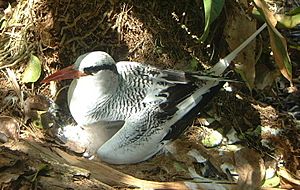South-west Saint Helena Important Bird Area facts for kids
The South-west Saint Helena Important Bird Area is a special place on the island of Saint Helena. This island is a British Overseas Territory located in the South Atlantic Ocean. This important area covers about 45 square kilometers, which is almost 37% of the whole island!
BirdLife International has named this spot an Important Bird Area (IBA). It's super important because many seabirds come here to build their nests and raise their young. These birds include the beautiful red-billed tropicbird. The area is also home to the Saint Helena plover, a unique bird found only on this island. Sadly, the Saint Helena plover is in great danger of disappearing forever.
What is the South-west Saint Helena Important Bird Area?
This special area covers the south-western part of Saint Helena. It stretches from Diana's Peak National Park all the way to small islands nearby. These small islands, like Egg, Speery, and Peaked Islands, are mostly made of a dark rock called basalt. There are also other rocky stacks and cliffs in the ocean. These rocky spots are perfect places for seabirds to build their nests.
The land here has four main types of plant areas:
- Dry Lowlands: Below 350 meters, the land is dry and has been worn away by weather.
- Middle Zone: Between 350 and 500 meters, you'll find grassy fields and forests with trees that are not native to the island.
- Moist Highlands: Higher up, there are more forests and areas where flax plants are grown.
- Highest Point: At the very top of the island, there's a small area with native Dicksonia ferns and Melanodendron cabbage trees.
The coast of this area has tall sea cliffs. Most of these cliffs rise between 300 and 570 meters high. The small islands are mostly bare rock. They have some lichens, which are like mossy growths, and a lot of guano, which is bird droppings. There's also an important place at Sandy Bay where scientists have found old fossils.
Birds of the Important Bird Area
This area is a vital home for many birds. For example, the rare Saint Helena plover has three main breeding spots here: Broad Bottom, Southern Pastures, and Man and Horse.
Besides the red-billed tropicbirds, many other seabirds come here to breed. These include:
- Band-rumped storm petrels
- Atlantic masked boobies
- Atlantic sooty terns
- Brown noddies
- Black noddies
- White terns
- And possibly, brown boobies
All these birds make the South-west Saint Helena Important Bird Area a very special place for wildlife!


